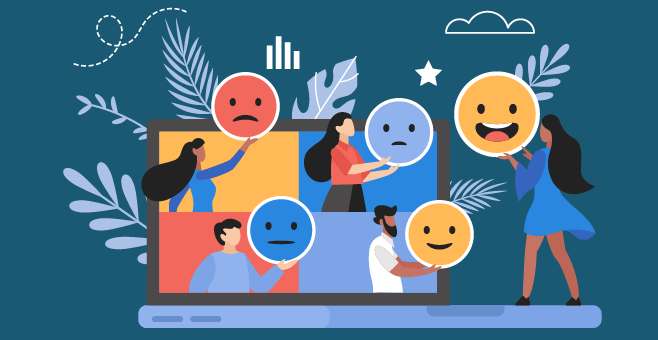Customer service expectations in the contact center continue to increase, and only the best businesses keep up. Customer service statistics show that superior CX generates more return customers, increases loyalty, and helps generate higher profits.
Here’s a comprehensive list of the most important customer service statistics you need to know in 2023. These stats cover everything from interaction channel preferences to customer expectations, and attitudes towards the current state of customer service to guide your strategy moving forward.
Statistics That Demonstrate the Value of Great Customer Service
Excellent customer service in the contact center has always been job one. It matters more than ever in an era where your customers will compare the experience they have with your brand against the biggest labels in the world. These stats demonstrate the value of offering excellent customer service.
Customers who receive excellent, effortless customer service are 94% more likely to buy the product or service again.
Source: Gartner
56% of customers say they would pay more for a product if it came with a guarantee of excellent customer service.
Source: ArenaCX
Customers are 5.1 times more likely to recommend your product or service after a positive experience.
Source: Qualtrics
A customer evangelist or promoter has a lifetime value 600 – 1,400% higher than a detractor.
Source: Bain&Co
Across the globe, 96% of consumers say customer service is an important factor in their choice of loyalty to a brand.
Source: Microsoft
As little as a 5% lift in customer retention can produce 25% more profits.
Source: Bain&Co
64% of people find customer experience more important than price when making a purchase.
Source: Gartner
If a company’s customer service is normally excellent, 78% of consumers will do business with them again after a mistake.
Source: Salesforce Research
52% of consumers say they have made an additional purchase from a company after a positive customer service experience.
Source: Dimensional Research
Americans will pay 17% more to do business with firms with great reputations in customer service.
Source: American Express
Companies that excel at customer experience delivery have revenues 4% to 8% higher than the rest of their market.
Source: Bain&Co
68% of customers say they will pay more for products and services from brands known to offer good customer service.
Source: HubSpot
93% of customers say they are more likely to purchase again from companies that provide excellent customer service.
Source: Hubspot
Consumers who rate a company’s service as “good” are 38% more likely to recommend that company.
Source: Qualtrics XM Institute
83% of customers agree that they feel more loyal to brands that respond and resolve their complaints.
Source: Khoros
Reducing your customer defection rate by 5% can increase profits by 25 to 125%.
Source: Leading on the Edge of Chaos, Emmet Murphy and Mark Murphy
62% of organizations view customer experience provided through contact centers as a competitive differentiator.
Source: Deloitte: Contact Center Survey
Increasing customer retention by just 2% has a similar impact as decreasing costs by 10%.
Source: Leading on the Edge of Chaos, Emmet Murphy and Mark Murphy
On average, a 1% improvement in First Call Resolution (F.C.R.) will result in a $276,000 reduction in annual operational costs.
Source: Bluewolf
Companies that prioritize providing a great experience saw a 10-15% increase in revenue and a 20% increase in customer satisfaction.
Source: McKinsey
Customers will spend up to 40% more with a company when satisfied with its customer service.
Source: Bain & Company
86% of customers are happy to pay more for a better experience, but only 1% think that businesses meet their expectations consistently.
Source: Forbes
$62 billion is lost by U.S. businesses each year following bad customer experiences.
Source: New Voice Media
40% of consumers start buying from a competitor because they hear about their reputation for excellent customer service.
Source: Zendesk

Statistics that Show the Impact of Poor Customer Service
Businesses today know that excellent customer service is required. On the other hand, having poor CS can have a measurably negative impact on your business. These statistics demonstrate the high cost of neglecting your customers.
69% of customers report having stopped doing business with a brand because of poor customer service.
Source: ArenaCX
9.5% of your revenue is at risk due to bad customer experiences.
Source: Qualtrics
When customers experience a high-effort customer service interaction, they are 81% more likely to share negative word-of-mouth information about the brand.
Source: Gartner
Acquiring new customers costs between 5 and 25 times more than retaining existing customers.
Source: Harvard Business Review
42% of Americans will stop shopping with a brand after only two bad experiences.
Source: Vision Critical
54% of people shared their bad customer service experiences with more than five people.
Source: Zendesk
33% of customers say they would consider switching brands after just one bad customer service experience.
Source: American Express
The average American tells 15 people when they’ve had a poor customer service experience.
Source: American Express
Men tell the most people (21 people) when they have had a poor customer service experience.
Source: American Express
On average, women tell about ten people when they have had a poor customer service experience.
Source: American Express
91% of customers unhappy with a brand will just leave without complaining.
Source: Kolsky
78% of customers have backed out of buying due to a poor customer experience.
Source: Glance
47% of consumers have switched to a different brand due to bad customer service within the last year.
Source: Microsoft
After a bad customer service experience, 39% of customers will avoid a company for the next two years.
Source: Dimensional Research
It can take up to twelve positive customer experiences to make up for one bad experience.
Source: Business Insider
Only 20% of consumers will forgive a bad experience at a company whose customer service they rate as “very poor.”
Source: Qualtrics XM Institute
Nearly 80% will forgive a bad experience if they rate the service team as “very good.”
Source: Qualtrics XM Institute
Only 1 in 26 customers will tell a business about their negative experience; the other 25 will simply leave without explaining or complaining.
Source: Esteban Kolsky
Feeling unappreciated by a company is the #1 reason customers switch brands.
Source: New Voice Media
The State of Customer Service in Statistics
Overall, customer service is looking good these days. Thanks to the rise of AI and other emerging technologies, contact centers can provide personalized experiences and resolve issues quickly. Businesses that offer great CX will notice an uptick in customer loyalty.
63% of US customers expect brands to offer customer service on their social media channels.
Source: Microsoft
63% of customers said companies need to get better at listening to their feedback.
Source: Qualtrics
89% of consumers have switched to doing business with a competitor following a poor customer experience.
Source: Harris Interactive
67% of people worldwide believe that customer service is improving as a whole.
Source: Microsoft
81% of Americans report that businesses either meet or exceed their expectations in customer service.
Source: American Express
46% of decision-makers expect their contact centers to grow between 5%-10% over the next year. 14% of contact center leaders predict growth of more than 10%.
Source: Forrester
80% of companies use customer satisfaction scores to analyze customer experience and improve it.
Source: Harvard Business Review
The customer experience management market worldwide is worth as much as $7.6 billion in 2020, up 16.9% from $6.5 billion in 2019.
Source: Grand View Research
53% of shoppers believe their feedback doesn’t go to anyone who can act on it.
Source: Microsoft
More than 89% of companies see customer experience as a key factor in driving customer loyalty and retention.
Source: invesp

Statistics on Customer Expectations of Service
Today’s customers expect companies to understand their needs and expectations – and they are becoming less patient with companies that don’t.
65% of people have higher expectations of customer service today than they did five years ago.
Source: Netomi
33% of people consider the most important aspect of good customer service to be having their problem solved in a single interaction, regardless of how long it takes.
Source: Statista
59% of customers believe that companies should offer cutting-edge digital experiences.
Source: Salesforce
Globally, 54% of all consumers say that they have higher customer service expectations than one year ago.
Source: Microsoft
48% of consumers expect specialized treatment for being a good customer.
Source: Accenture
52% of people around the globe believe that companies need to take action on feedback provided by their customers.
Source: Microsoft
72% of consumers say that they expect customer service agents to “know who they are, what they have purchased, and have insights into their previous engagements.”
Source: Microsoft
77% of consumers view a brand more favorably when they proactively ask for and collect customer feedback.
Source: Microsoft
68% of customers believe the key to great customer service is a polite customer service representative.
Source: American Express
Service insight and knowledge are also key to a good experience, according to 62% of consumers.
Source: American Express
67% of customer churn could be prevented if companies resolve problems the first time they happen.
Source: Ameyo
12% of Americans rate their number one frustration with customer service as “lack of speed.”
Source: Statista
A customer is four times more likely to switch to a competitor if the problem they’re having is service-based.
Source: Bain and Company
27% of Americans report “lack of effectiveness” as their number one frustration with customer service.
Source: Statista
72% of consumers see explaining their problem to multiple people as poor customer service.
Source: Dimensional Research
90% of consumers expect an online portal for customer service.
Source: Microsoft
79% of millennials are more inclined to buy from brands with a mobile-responsive customer support portal.
Source: Microsoft
90% of consumers worldwide consider issue resolution their most crucial customer service concern.
Source: KPMG
71% of consumers under the age of 24 think that a fast response from the customer support team can significantly improve their customer experience.
Source: Comm100
80% of customers say a company’s customer experience is just as important as its products or services.
Source: Salesforce
33% of consumers would recommend a brand that provides a quick but ineffective response.
Source: Nielsen-McKinsey
Only 17% of consumers will recommend a brand that provides a slow but effective solution.
Source: Nielsen-McKinsey
72% of customers say that explaining their problems to multiple people is poor customer service.
Source: Dimensional Research
70% of people favor brands that proactively notify customers about service interruptions or potential issues.
Source: Microsoft
82% of customers expect to solve complex problems by talking to one person.
Source: Salesforce
Contact Center Customer Service About AI and Automation
AI-enabled systems and software are having a moment. These computer-driven technologies boost customer service in the contact center, and provide measurable results and significant financial benefits to businesses.
99% of respondents reported an increase in customer satisfaction resulting from using virtual agent technology.
Source: IBM
Speech analytics can increase customer satisfaction by 10% or more.
Source: McKinsey
90% of customers expect an immediate response (in under 10 minutes) when they contact customer service. AI-assisted communications are one of the best ways to get there.
Source: HubSpot
IBM found that virtual assistants led to 15% reduction in call handling time and a 9% and 12% increased customer and agent satisfaction (in two different studies.)
Source: IBM
High-performing service teams are 3.2 times more likely than underperformers to have a defined A.I. strategy.
Source: Salesforce
51% of agents without A.I. say they spend most of their time on mundane tasks, versus 34% of agents with A.I.
Source: Salesforce
More financial services firms have adopted A.I., with 41% using some form of A.I. compared to other sectors. For example, only 13% of education institutions are using A.I.
Source: Salesforce
Only 9% of governments use A.I. chatbots compared to 42% of media and communications companies.
Source: Salesforce
The travel and hospitality industry expects the use of Artificial Intelligence tools in customer interactions to grow 187% over the next two years.
Source: Salesforce
Ameyo estimated that by 2020, 85% of customer service interactions will be automated.
Source: Ameyo
30% of U.S. consumers rate chatbot interactions as “very effective” in dealing with customer support problems.
Source: Microsoft
37% of customers report using a chatbot on a website. Nearly that many again have used a virtual agent or chatbot on their smartphone.
Source: Forrester
More than 50% of customers say the main reason they can’t resolve an issue on their own is there is not enough information available online.
Source: Microsoft
30% of consumers say not reaching a real human is the most frustrating part of a bad customer service experience.
Source: Microsoft
77% of consumers report having used a self-service support portal.
Source: Microsoft
Only 12% of Americans say they cannot find the information they need in self-service portals.
Source: Microsoft
American consumers do not find bots effective, with 40% relying on other channels to reach out to service teams.
Source: Microsoft
75% of consumers will still choose to interact with a real person even as the technology for automated solutions improves.
Source: PwC
69% of high-performing service agents actively look for situations to use Artificial Intelligence compared to only 39% of underperformers.
Source: Salesforce
34% of sales and marketing leaders believe that artificial intelligence will cause the biggest improvement in customer experience.
Source: Oracle

Statistics About Customer Service Communication Channels
Customers can choose from multiple channels to receive service, including phone, email, chat, social and more. It’s important that contact centers understand which channels people prefer, and provide a seamless experience across all of them.
40% of consumers say they have used three or more channels to communicate with customer service reps.
Source: Airkit
66% of customer service teams use knowledge bases, compared to 82% of customers who use knowledge bases (e.g., online F.A.Q.s).
Source: Salesforce
64% of customer service teams use customer portals, compared to 84% of customers who use customer portals.
Source: Salesforce
63% of customer service teams use text messaging, compared to 78% of customers who use text messaging for communicating with a company.
Source: Salesforce
81% of customers use online chat for communicating with a company, but only 52% of customer service teams use live chat.
Source: Salesforce
63% of online consumers said they were more likely to return to a website that offers live chat.
Source: Forrester
51% of customer service teams use mobile apps, compared to 82% of customers who use mobile apps for communicating with a company.
Source: Salesforce
20% of customer service teams use voice-activated personal assistants, compared to 54% of customers who use voice assistants to communicate with a company.
Source: Salesforce
Millennials prefer live chat for customer service over every other communication channel.
Source: Comm100
57% of customers would rather contact companies via digital media such as email or social media than voice-based customer support.
Source: Ameyo
40% of customers prefer talking to a real person over the phone for more complicated interactions, such as payment disputes.
Source: American Express
52% say Facebook is the most effective social channel for customer service. Twitter follows at 25%, then LinkedIn at 8%.
Source: Salesforce
23% of consumers look for face-to-face interaction when they have a complicated customer service issue like troubleshooting.
Source: American Express
75% of customers want a consistent experience, regardless of the channel they use to communicate with a company.
Source: Salesforce
76% of all consumers prefer phone calls to reach customer support representatives.
Source: CFI Group
More than 50% of customers use the phone to contact customer support, making it the most-used channel for customer service.
Source: Zendesk
63% of customer service teams use text messaging, compared to 78% of customers who use text messaging for communicating with a company.
Source: Salesforce
72% of consumers have a more favorable view of a company if they provide a customer service app.
Source: Nuance
69% of American adults online say that they shop more with businesses whose online and offline customer service is consistent.
Source: Forrester
87% of consumers say brands need to be doing more to provide a seamless experience for their customers.
Source: Zendesk
Customer Service Statistics About the Importance of Personalization
Personalization in customer service is increasingly important as customers demand tailored experiences that meet their specific needs and preferences. In 2023, businesses that can leverage technology to personalize interactions and anticipate customer’s preferences will have a competitive edge.
80% of business leaders say customers spend more when they get a personalized experience.
Source: Segment
63% of consumers expect businesses to know their unique needs and expectations
Source: Salesforce Research
Your online conversion rate can improve by roughly 8% when you include personalized consumer experiences.
Source: Trust Pilot
79% of customers are willing to share relevant information about themselves in exchange for personalized interactions where they are immediately identified and understood.
Source: Salesforce
Statistics that Show the Importance of Speed and Short Wait Times
Short wait times have become a crucial factor in providing excellent customer service and today’s customers expect immediate responses from brands they interact with.
80% of customers say they want quicker responses from companies.
Source: Shopify
47% of adults say they will abandon their online purchase if they can’t find a quick answer to their question.
Source: Freshworks
64% of customers expect to receive real-time support, regardless of which channel they use.
Source: Zendesk
90% of consumers regard immediate responses as important when they have a query.
Source: Hubspot
Nearly 70% of customers are irritated when their call is transferred between agents or departments.
Source: Zendesk
21% of people waiting at a hospital pharmacy decided to fill their prescriptions elsewhere because they had to wait too long.
Source: Sage Journals
33% of customers are most frustrated by having to wait on hold.
Source: HubSpot Research
33% of customers are most frustrated by repeating themselves to multiple support reps.
Source: HubSpot Research
Nearly 60% of customers feel that long holds and wait times are the most frustrating parts of a service experience.
Source: Zendesk
90% of customers rate an “immediate” response as important or very important when they have a customer service question. 60% of customers define “immediate” as 10 minutes or less.
Source: HubSpot
12% of Americans rate their number one service frustration as “lack of speed.”
Source: Statista
66% of U.S. adults said the most important thing a company can do to provide a good customer experience is to value their time.
Source: Forrester
71% of consumers under 25 believe quick responses from customer service representatives improve their experience.
Source: Comm100
73% of customers say that time is critical in determining a good customer service experience from a poor one.
Source: Hubspot
Proactive customer service messaging can result in a 20-30% reduction in call center calls. That can lower contact center costs by as much as 25%.
Source: Enkata/MyCustomer
75% of online customers expect help within five minutes.
Source: McKinsey
33% of customers said they’re not willing to wait on hold at all. 27.6% said they would wait 1 minute, and only 4.1% said they’d wait as long it took.
Source: Plum Voice
Customer expectations for chat response times are high, and are willing to wait just 45 seconds to speak to an agent.
Source: Com100
Customer Service Statistics About Personal Data and Security
In an age where data breaches and cyber-attacks are becoming increasingly common, customers are more cautious about sharing their personal information. Ensuring the security and privacy of customer data is crucial for building trust and maintaining a loyal customer base in the contact center industry.
Two-thirds of global consumers feel that tech companies have too much control over their data.
Source: YouGov
80% of companies store sensitive data in the cloud.
Source: Netwrix
92% of customers appreciate companies giving them control over what information is collected about them.
Source: Salesforce
90% of people are more likely to trust a company if they have a firm privacy policy.
Source: Salesforce
56% of customers don’t have a problem sharing their personal information in exchange for better customer service.
Source: Salesforce
Customer service agents only ask for a customer’s name 21% of the time.
Source: Glance
Statistics About Customer Service and Social Media
Providing excellent customer service on social media helps businesses maintain a positive brand image and reputation. Customers expect it and take note when it isn’t available. Providing great CX on social can also turn dissatisfied customers into loyal ones, and improve retention rates.
48% of consumers expect a response to social media questions and complaints within 24 hours.
Source: Statista
33% of consumers in the United States do not expect an answer when asking a question of a company’s social media.
Source: Statista
33% of people aged 18-34 have contacted a company’s customer service via social media.
Source: Microsoft
55% of people age 18-34 have praised a brand or its customer service over social media.
Source: Microsoft
Both in the United States and worldwide, 18% of customers expect a response from a company’s social media within one hour.
Source: Statista
65% of people aged 18-34 believe social media is an effective channel for customer service, while 75% of people aged 55 and over do not.
Source: Microsoft
One-third of Americans have used social media to complain about a brand or its customer service.
Source: Microsoft
It’s estimated that companies only acknowledge around 45% of customer service requests over social media.
Source: Kolsky
33% of customers have contacted a company using Facebook and similar social channels.
Source: Forrester
23% of businesses use social media as a tool to collect and analyze data.
Source: Gartner
Statistics on Customer Service Representatives and Agent Satisfaction
Employee satisfaction and engagement are critically important to a contact center’s ability to deliver great customer service. Happy agents equal happy customers.
73% of contact center leaders report that agent turnover is one of the most significant customer service problems in their contact center.
Source: Cisco
The customer service industry has the highest employee turnover rate of all businesses. Call center statistics have placed it as high as 45%!
Source: QATC
The Human Resource Institute estimates that turnover costs about $10k-$15k for a frontline employee.
Source: QATC
31% of consumers consider a knowledgeable agent the most crucial factor for a positive customer experience.
Source: Thomasnet
83% of high-performing service agents say they get the training they need to do their job well compared to only 52% of underperformers.
Source: Salesforce
73% of customers fall in love with a brand because of friendly customer service representatives.
Source: RightNow
Engaged, knowledgeable employees deliver a better customer experience and close 33% more deals.
Source: Bluewolf
Only 31% of businesses reward employees for improving the customer experience.
Source: Forrester Research
65% of organizations that focus on frequent training see advantages in First Call Resolution.
Source: Aberdeen Group
Companies that excel at customer experience have 1.5x more engaged employees than companies with poor customer experience.
Source: Customer Contact Mind Xchange


